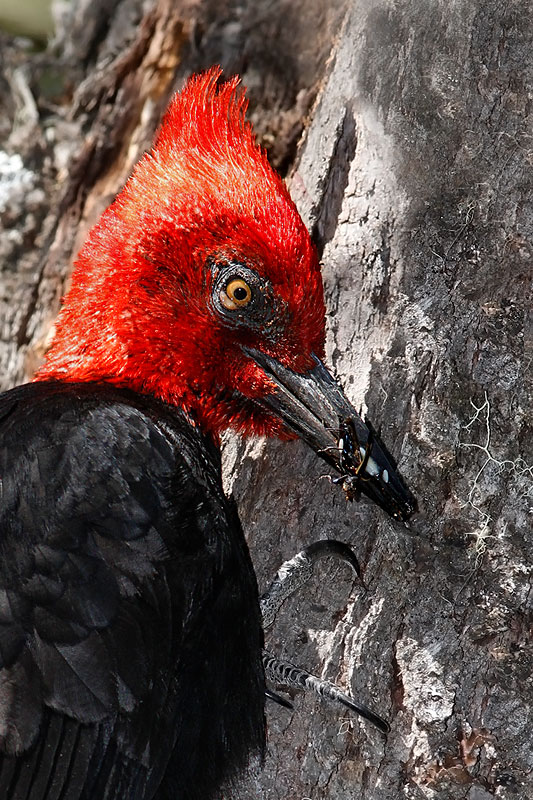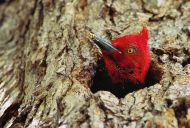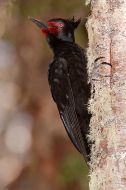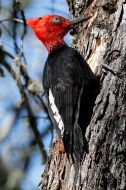Magellanic Woodpecker
Carpintero Negro Gigante
Campephilus magellanicus
Length: 430mm. Sexes unlike. Male: bill slate grey; iris greenish yellow; head, crest and neck up to halfway its length bright red vermillion. Base of neck, plumage on upperparts and rectrices entirely black, on back and upper breast showing bluish sheen. Wing coverts black with bluish sheen; primaries and secondaries on upperside show outer vexillum black, with inner vexillum also black except for the base, that is white; the white at the base of the inner vexillum of the remiges is increasingly broader until this colour covers almost entirely the most proximal secondaries, except for the tip, that is black; underwing coverts of the bend of wing are black, remainder of underwing coverts and axillaries are white; the underside of remiges are entirely white to base; when perched two white longitudinal stripes are revealed, on account of the tertiaries being white on the inner vexillum and part of the outer vexillum, and they are exposed. Legs grey. Female: head entirely black with bluish sheen, except for feathers covering the base of the bill, that are red; rest of plumage is identical to the male; the crest shown by females is long and recurved, whereas in the male it is much shorter. Juvenile: male juveniles do not have read in all the head, some adult individuals show white longitudinal stripes on teritiaries with black barring. Unmistakable by its large size and coloration, the Magellanic Woodpecker is the largest species of all members of the family Picidæ found in South America, and one the most typical and representative birds of the sub-Antarctic woods. Habitat and behaviour: almost always found in pairs or small groups ranging from three to eight individuals. They forage the woods, especially those of Nothofagus (Lenga, Coihue, Ñire and other), their presence being very infrequent in other arboreal species. The voice of the Magellanic Woodpecker is strong and the hammering of its bill on timber is far-carrying. It feeds on larvae of a wide variety of xylophagous coleoptera that are parasites both on living and dead trees, according to species. It forages the forest, flying from one tree to the other, perching midway or moving to the top branches along trunks and limbs by hopping, all the while searching thoroughly. Very seldom will it go down to the ground to feed. It often feeds, however, on fallen branches. Its potent cry is heard more often right before the bird takes wing or when it is already flying. Since it does not always emit vocalisations and the loudness of the hammering on wood depends whether it is green or dry timber, to see this species in the large and silent forest, one must walk slowly and listen attentively. When it becomes aware of the presence of strangers, it hops to the opposite side of the trunk where it is perched, where it remains very quiet to pass unnoticed. To fly it almost always takes off from the higher branches. After a short run, it perches vertically on a nearby tree, and when it tracks down some grub beneath the bark by the sense of hearing, it begins to perforate it with its powerful bill. Occasionally it will hop to the opposite side of the trunk and begin its hard work, giving a few powerful blows, coming back to the other side and continuing in this way until its extremely long tongue reaches its prey.
The forests inhabited by this species can be told by the large number of scars impinged on the trees when this bird seeks its food. The nest is built in holes excavated in tree trunks where up to four eggs are laid. Fortunately the population of this species is still quite common, although human encroachment, together with large fires breaking out each year have affected the forests that make up its habitat, most likely seriously damaging its population. Range: from Neuquén to southern Tierra del Fuego, within the boundaries of the Andean Patagonian forests. In Chile it is found from Curicó to the Chilean Tierra del Fuego.
Illustrated Handbook of the Birds of Patagonia
Kindness: Kovacs Family |












